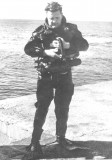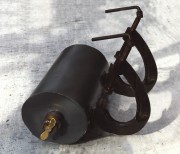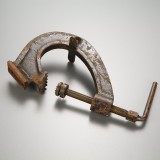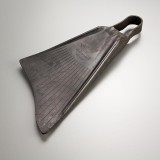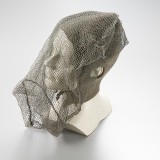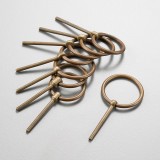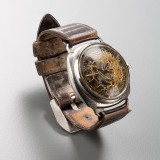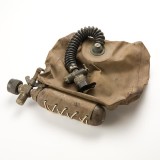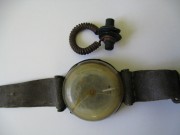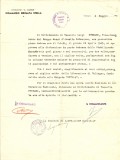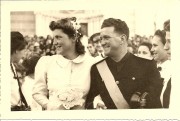A War Hero
A man
Orion
|
June 30th, 1943 - Iskenderun - Turkey. The man swims on his back towards the ship, but keeps his arms hanging loosely along his sides, motionless, and advances using only his outstretched legs, alternately, just as in competitive backstroke. The thrust of his legs, aided by the pair of rubber fins he is wearing on his feet, compensates for the loss of arm traction. These fins were a secret device. They are heavy enough to hold the swimmer's feet under the water surface to avoid splashes or any suspicious noises. Utter silence and absolute invisibility are an essential part of the equipment and armament of any man enrolled in the “Gamma” Group. Men belonging to the Gamma Group, in the Decima Flottiglia MAS of the Italian Royal Navy, have many problems to contend with. They are not allowed to emit a single sound and know only one colour: black. Black like the rubber fins, black like the dive suit covering the entire body of the commando, black like the ragged veil concealing his face, the thick woollen Phrygian cap supporting the greenish veil. A dive mask would be inconceivable, the front glass could reflect any insignificant glimmer of light and the invisible enemy would no longer be so. The ship is still far out, there is no noise to be heard, not a voice. No light can be seen, not even a glimmer, which would help him to stay on course. Yet it is too close for the Gamma to be able to afford the luxury of a single cough, or exhaling like a whale to expel all the salt water entering his nose. Someone, on board, might be able to hear that faint noise and become suspicious, raise the alarm, direct floodlight beams against the black surface of the sea, then get the machine gun to aim at the floodlit puddles - the commando would have no escape. Of course, if they aimed a burst of machine gun fire at him and a couple of shots hit one, or even both explosive limpet mines the attacker carries with him, the mission of the Gamma would fail. He would die in vane and the operations his fellow soldiers are preparing elsewhere in the Mediterranean would be uncovered and stopped in time by the enemy. He slices through the water, kicking the secret weapon, his fins, and drags the limpet mines he has to apply towards the target. He keeps them at his sides, well packed with explosives, his arms resting on them so he can control them with his hands and be more comfortable. They are kept in place by two cords passing through the same number of rings, which, in turn, are fixed to the swimmer's shoulders with two braces. These, combined with the tight belt around the waist, form a strong harness. Supported by appropriate floats, he also uses the two devices for support and to catch his breath now and again. Finally, only a few dozen metres of dark water lay between him and his goal. The Gamma Man deflates the limpet mines' floats a little, with extreme care. The devices disappear under the surface but do not sink, they just remain there, hanging just below the water surface. He has only enough strength left to kick his fins and advance at an almost imperceptible speed, like that of a dead body adrift. His head tilted backwards, under the veil his eyes remain wide open in the darkness of the water. He is fully immersed, helped by the limpet mines, which are now slightly heavy. Only his nostrils and mouth show above the water. He expels the water from his mouth without any problems. But not from his nose. The Gamma knows that if he blew it out, the salty liquid would stimulate the mucous lining and he would inevitably cough. He makes up for it by swallowing. There is no other solution. He knows it will leave him burning with thirst, and that he will have to stand it, as he will have to stand the cold, the nervous tension, the fear. Minor troubles. There is no sign to be seen or sound revealing his presence below the merchant ship loaded with chrome. Using the bare fingertips of his black-smeared hands, the commando feels the iron underside of the ship until he recognises the typical bulge of the welding; an unquestionable indication of the edges of two superimposed metal sheets. All he has left to do now is to tell, by touch, the long joints of the metal sheets indicating the hull's longitudinal axis from the short ones that run along the transverse axis. Should all go well, he knows there will be no letters of commendation or articles in the newspapers. He also knows that should it all go wrong, he could end up in a concentration camp with POW imprinted on his coat (Prisoner of War). Should he get nailed ... he will not be held prisoner but shot at once. They would take him for a spy, a saboteur. Yes. But a civilian nonetheless. Someone to be executed without trial. Now the second charge is in place. They will explode and the ship will sink outside territorial waters. The enemy will think it was hit by a submarine, as it incorporates a time and distance measuring device to set off the explosive. A small propeller that will only start spinning once the ship has reached the speed of five knots, releasing the catch of the clock. This, in turn, will trigger the detonator after a certain number of hours. Mission complete. But it’s too soon to say that; he has to return to the beach, his secret base, without letting anyone spot him. Now he beats his fins in silence in the direction of the beach, a good mile and a half away from the anchored ship that will sink in less than a few hours. Finally he reaches land, in a wet, ragged silence. He is no longer carrying the limpet mines and advances, swift and invisible, in his black dive suit, the veil still concealing his face. It is three o' clock in the morning and, at last, there is not a soul in sight. The Gamma Man dries himself off with the bath robe he left in the cabin, puts his clothes back on and heads to the Royal Italian Consulate. Giovanni Roccardi, D65 SIS agent who helps him out and who is the only person aware of Ferraro's true identity, anxiously awaits him. Mission complete. Now he can say it. The consul is also waiting for him. The secret agent has only just informed him of the true identity of this bizarre employee of his and on the nature of his assignment. Now that the consul is aware of it, he can stay here for the night. It is almost four in the morning. It is not worth walking all the way to his accommodation at the Carmelite Convent, where the secret service official from the Italian Navy placed him, as it was safer than a hotel room. And the monks know that he is a civil servant at the Italian Consulate in Iskenderun and would certainly not impose their time schedules upon him. Besides, what harm could someone like him do? Luigi Ferraro, a young man from Genoa who cannot even swim. Who, instead of going to war, managed to skulk behind a typewriter in a remote consulate, in a neutral country town. "A person with connections" the father guardian thought to himself, the moment he first laid eyes on him." (1) |
|
Kaituna
|
The second operation takes place on the 9th of July in the port of Mersina. At 22:20 Ferraro lowers himself into the water and starts swimming in the direction of the merchant ship Kaituna, anchored two or three kilometres away. At one o' clock in the morning he is forty metres from the bow of his target. He floats along the surface of the sea, slowly creeping towards the ship, a veil concealing his face: a brown tuft of seaweed. As his body touches the steel bulb, the commando stays unmoving: he must regain his strength, slow his heart beat, his breath's rhythm. He is on his way again. The brown tuft of seaweed gradually rolls away, sliding along the right side of the ship. As he reaches the bilge keel on the right he stops, and slowly vanishes into the sea. Ferraro starts breathing pure oxygen from his rebreather and has dived . Weighing on him, an unsettling feeling that he might have detected, by touch, of course, a verrina - a cable that is passed from one side to the other underneath the keel and run from bow to stern and back to check that there are no foreign objects on the ship; bugs, limpet mines or other tricks devised by the enemy. The commando immediately finds the keel, moves to the rear, attaches the first limpet mine, tearing its float and pulls out the fuse safety catch. One down. Now, without losing contact with the keel, he pushes towards the front where the second limpet mine has to be placed. Damn! And there was the verrina. Ferraro is perplexed, hesitant, worried. He still decides to attach the second charge, nonetheless, securing it well with the clamps. He takes all necessary actions so that the limpet mines are ready to explode. But he becomes uncertain: "should I remove those limpets? What if they find them with the verrina ... " He checks the sliding connector: he verified its functionality in person. It is a device that has been especially designed and developed to deceive the enemy's verrine: "no... it should work, they'll never find them ... "
|
|
Sicilian Prince
|
The third target: the Sicilian Prince, flying the British flag and 4,500 grt., is attacked during the night of the 30th of July. |
Fernplant
|
Less than two days later, right in Iskenderun, there is a great opportunity to make the best use of the last two limpet mines. At 2,000 metres from the beach, the Fernplant is anchored, a Norwegian steamship with an overall length of 127 metres, a tonnage of 5,274 tons and a deadweight tonnage of 7,000. It is loaded with 6,000 tons of chrome ore. (1) |
|
After September 8th
|
After the war was lost, Ferraro persevered with another war, until the final defeat in 1945. In this war, he didn't kill anyone, never fired against other Italians. On the contrary, in agreement with the partisans who, in theory, were his enemies, he saved men and important industrial estates from the Nazi retaliation. "On April 26th, the Council Secretary and two representatives of the C.L.N. came here and said: "The authority passed from the Social Republic over to the C.L.N., we need your help [ ... ] there is a German column that wants to blow up the bridge and the premises". I answered that I was and remained the highest military authority in the country. Therefore, in order to save the bridge and the Marzotto premises, I would have to intervene in person by leading the German column out of Valdagno, without causing any difficulty to the partisans. On May 27, Lieutenant Commander Lionel Crabb, a famous Royal Navy "frogman" and Major Antony Marzullo from the U.S. Navy, arrived in Valdagno and offered Ferraro cooperation with the allied navy forces in the war against Japan. Ferraro thanked them for the proposal but refused. |
|
S. Giovanni Bianco
|
SAN GIOVANNI BIANCO - SUMMER '45. - "There he is!" As the comrade exclaims, our faces jerk in unison in the direction of the voice. Blimey, at the pier on the opposite shore the "Masked Man" stands upright. And who has ever come across a diver other than in comics? Not even the author of these lines has ever seen anything more than the port dock diver, despite his extended residence in San Remo due to his father's work. We recognise that young man with the chestnut blonde goatee by his athletic figure and his blue shorts. The same man who walked past us not long ago as he played with the little blond boy splashing about a few steps away. Now he is talking to him from the pier on our shore. Cautiously, we move towards the bridge. Rather than the strange goggles that almost cover his face, his enormous webbed feet and the equipment of that mysterious character, we are more intrigued by the object he is holding. It is certainly a weapon, but we have never seen anything like it before. And I must say, that after meeting the German Army, various militants from the Social Republic, partisans and other soldiers, we were used to seeing rifles and machine guns. This one, on first glance, reminds us of a machine pistol as it is longer and more slender, but it does not have The man breathed out and in deeply then lowered himself into the water. Moving his arms in a perfect "crawl", greatly admired by us since we can hardly manage a "doggy paddle", he dived in and started swimming in the direction of the "Orobica" dam. Following up the gravel bed with no further hesitation, we watched him as he moved against the tide together with the little blond boy. We got a glimpse of him stopping for a moment and rapidly manoeuvring his crossbow/musket. Then he re-emerged and we were suddenly surprised by the view of a nice trout dangling from the forked dart that went through it. Returning to the water, he soon had another catch. As he got back to the shore, one of the spectators from our gradually expanding group suggested that he should try in the deep pond underneath the spillway. Smiling, he replied that he caught enough for that day. Some of my friends, who where present at the event, later told me that he went back and dived into that same spot a few days later: so that he could gather half a dozen trout and graylings, which were stranded in a ravine in the rocky seabed, whipped by the explosion of a carbide device (some think it was actually a hand grenade). It was one of us who threw it, one of the strongest of our gang. After re-emerging, the magnanimous harpooner approached the bomber holding the fish pierced through with a small willow branch and said "Here you go, take them to your mum". The young man left ecstatic with his wonderful treasure: food rationing still persisted at the time, and it was strict. It was only years later that they learned that the "Masked Man" was Luigi Ferraro, the Lieutenant Commander. The Italian Army grapevine circulated word that he was a secret service officer, an ace in the submarine war. Well, that wasn't all that far-fetched. He used to live in Villa Alexandra, with his young son and his wife, a pretty lady, and this was a fact. During his explorations in the Brembo area, he noticed that the seventeenth-century pillars were dangerously deteriorating. He warned the Council, who saw to it immediately. Maybe, if the charming Ponte dei Frati is still standing, we owe it to the sinker from Iskenderun. Taken from “Le trote del Vescov dopo le navi di Winston” - by Bernardino Luiselli – Ed. 2005 Yearbook by the Italian Alpine Club of the High Brembana Valley. |
Orietta, his wife
|
In the winter of 1943, in northern Africa, the British Army's VIII Corps advanced after defeating the Italo-Germans in El Alamein and the fall of Tripoli was almost inevitable. Ferraro was then appointed to carry out sabotage actions in his adoptive city once the enemy had occupied it. It was not advisable to employ anyone who was foreign to the area for collaboration purposes, as they would have certainly aroused attention and suspicion. |
|

